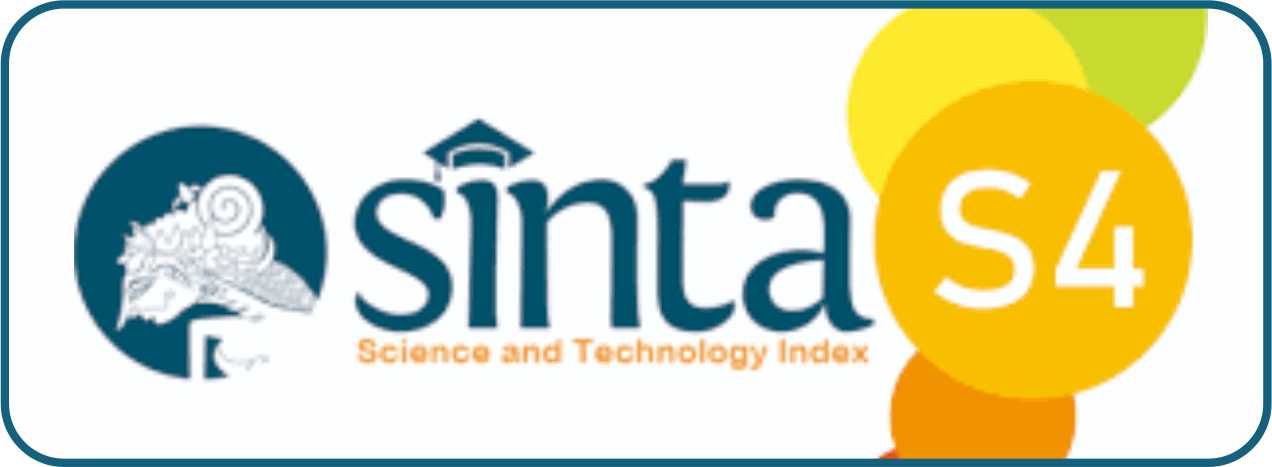Decision Support System For Selection Of Productive At Sahabat Sampulo Foundation Using The Profile Matching Method
Abstract
Keywords
Full Text:
PDFReferences
Wang, Z. (2021). Human resource management mode based on big data. Journal of Physics: Conference Series, 1852(2), 01-08.
Sari, J. P., dan Yusa, M. (2020). Penentuan karyawan terbaik pada collection PT. Panin Bank menggunakan metode smart. seudocode, 7(2), 157-164.
Munawir, M., dan Ardiansyah, A. (2017). Decision support system pemilihan karyawan berprestasi dengan pendekatan analisa gap profile matching di kantor perwakilan bank indonesia provinsi aceh. Jurnal JTIK (Jurnal Teknologi Informasi dan Komunikasi), 1(1), 7-14.
Sudrajat, B. (2018). Pemilihan pegawai berprestasi dengan menggunakan metode profile mathcing. Jurnal dan Penelitian Teknik Informatika, 3(1), 202–210.
Vargas, I. G., and Braga, R. T. V. (2020). Understanding system of systems management: A systematic review and key concepts. IEEE Systems Journal, 16(1), 510-519.
Prasetiyo, B., Baroroh, N., and Rufiyanti, D. E. (2016). Fuzzy simple additive weighting method in the decision making of human resource recruitment. Lontar Komput. J. Ilm. Teknol. Inf, 7(3), 174-181.
Purwanto, H. (2017). Penerapan metode profile matching dalam sistem pendukung keputusan penilaian kinerja karyawan pada Pt. Hyundai mobil indonesia cabang kalimalang. J. Techno Nusa Mandiri, 16(1), 34–40.
Muhammad, M., Safriadi, N., dan Prihartini, N. (2017). Implementasi metode simple additive weighting (SAW) pada sistem pendukung keputusan dalam menentukan prioritas perbaikan jalan. Jurnal Sistem dan Teknologi Informasi (JUSTIN), 5(4), 223-228.
Nioga, A., Brata, K. C., dan Fanani, L. (2019). Evaluasi usability aplikasi mobile KAI access menggunakan metode system usability scale (SUS) dan discovery prototyping (Studi Kasus PT KAI). Jurnal Pengembangan Teknologi Informasi dan Ilmu Komputer, 3(2), 1396-1402.
Kuswanto, J. (2020). Penerimaan karyawan baru menggunakan metode profile matching. Jurnal Processor, 15(2), 85-97.
Lucitasari, D. R., and Khannan, M. S. A. (2019). Designing mobile alumni tracer study system using waterfall method: an android based. International Journal of Computer Networks and Communications Security, 7(9), 196-202.
Saputro, H., Wahyudin, I., and Iskandar, A. (2020). Development of a web-based online library information system at the national university using the waterfall method: development of a web-based online library information system at the national university using the waterfall method. Jurnal Mantik, 4(1), 300-310.
Suhirman, S., Hidayat, A. T., Saputra, W. A., and Saifullah, S. (2021). Website-based e-pharmacy application development to improve sales services using waterfall method. International Journal of Advances in Data and Information Systems, 2(2), 114-129.
Aroral, H. K. (2021). Waterfall process operations in the fast-paced world: project management exploratory analysis. International Journal of Applied Business and Management Studies, 6(1), 91-99.
Mahadevan, L., Kettinger, W. J., and Meservy, T. O. (2015). Running on hybrid: control changes when introducing an agile methodology in a traditional “waterfall” system development environment. Communications of the Association for Information Systems, 36(1), 5.
Jaya, T. S. (2018). Pengujian aplikasi dengan metode blackbox testing boundary value analysis (studi kasus: kantor digital Politeknik Negeri Lampung). Jurnal Informatika: Jurnal Pengembangan IT, 3(1), 45-48.
Febiharsa, D., Sudana, I. M., dan Hudallah, N. (2018). Uji fungsionalitas (blackbox testing) sistem informasi lembaga sertifikasi profesi (SILSP) batik dengan appperfect web test dan uji pengguna. Joined Journal (Journal of Informatics Education), 1(2), 117-126.
Hidayat, T., dan Muttaqin, M. (2018). Pengujian sistem informasi pendaftaran dan pembayaran wisuda online menggunakan black box testing dengan metode equivalence partitioning dan boundary value analysis. Jutis (Jurnal Teknik Informatika), 6(1), 25-29.
Supriyono, S. (2020). Software testing with the approach of blackbox testing on the academic information system. IJISTECH (International Journal of Information System and Technology), 3(2), 227-233.
Munthe, I. R., Rambe, B. H., Pane, R., Irmayani, D., and Nasution, M. (2020). UML Modeling and Black Box Testing Methods in the School Payment Information System. Jurnal Mantik, 4(3), 1634-1640.
DOI: https://doi.org/10.17509/coelite.v2i1.57092
Refbacks
- There are currently no refbacks.
Journal of Computer Engineering, Electronics and Information Technology (COELITE)
is published by UNIVERSITAS PENDIDIKAN INDONESIA (UPI),
and managed by Department of Computer Enginering.
Jl. Dr. Setiabudi No.229, Kota Bandung, Indonesia - 40154
email: coelite@upi.edu
e-ISSN: 2829-4149
p-ISSN: 2829-4157




